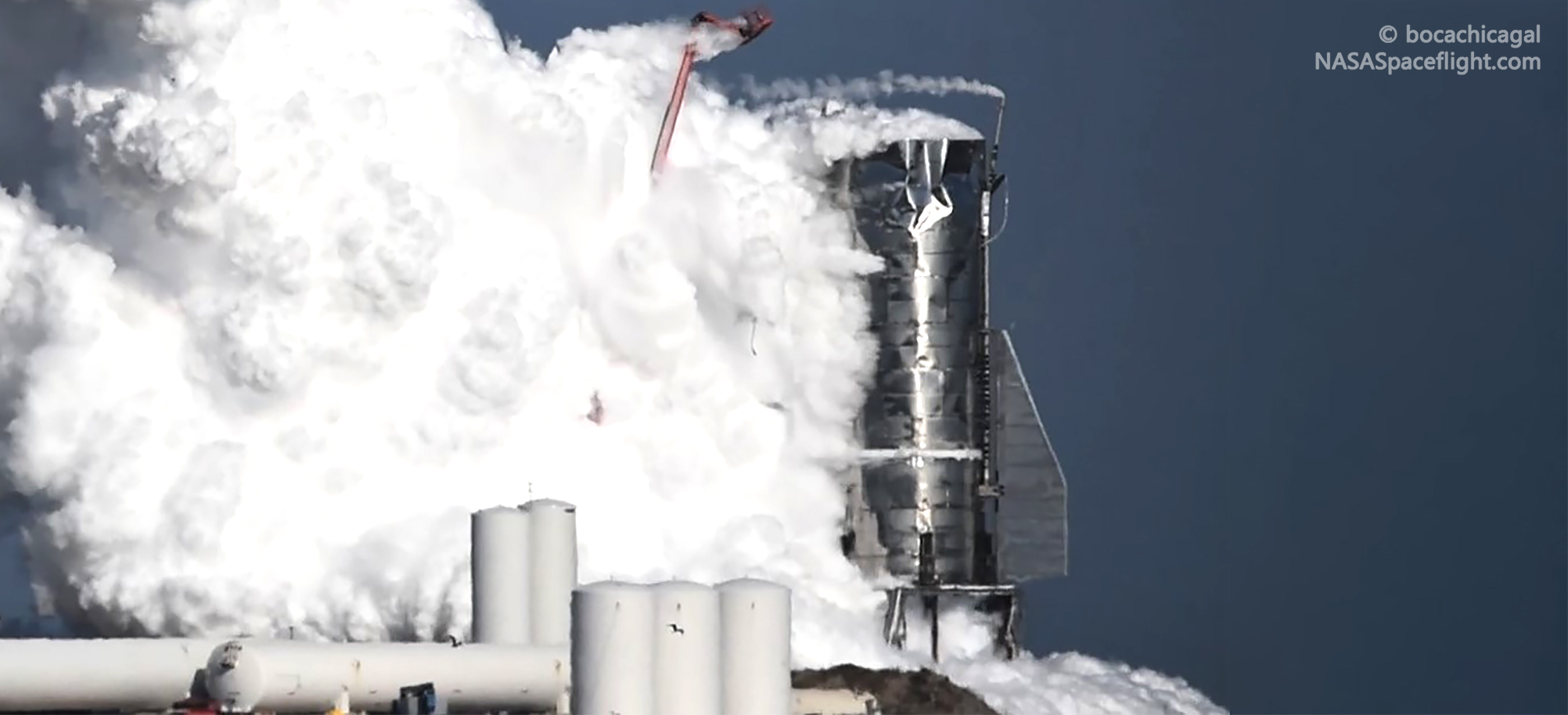
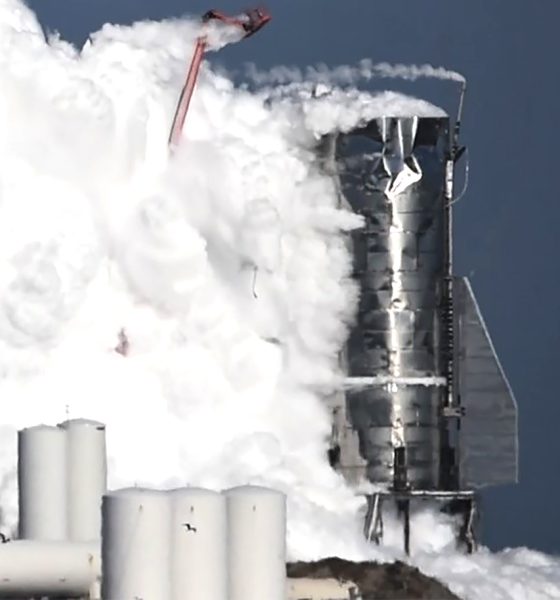
News
SpaceX Starship blew its top during rocket fueling test (updated)
Update: SpaceX has released an official statement indicating that Starship Mk1’s November 20th failure came after a decision to intentionally pressurize the rocket prototype to its limits. This likely means that the test was to max flight pressures and not an intentional burst test, so Starship’s dome failure is still a significant concern and was definitely not planned.
More importantly, SpaceX says that it had already decided to retire Starship Mk1 before any kind of flight testing, treating the vehicle as a pathfinder. Instead, SpaceX will build and use Starship Mk3 – the next Boca Chica prototype – for Starship’s first attempted skydiver-style landing and 20 km (12 mi) flight test.
SpaceX statement on the above test and incident: pic.twitter.com/r1ReRYhUhz— Michael Sheetz (@thesheetztweetz) November 21, 2019
SpaceX’s first full-scale Starship prototype has suffered a significant failure during testing, destroying or severely damaging large sections of the rocket. However, SpaceX CEO Elon Musk has already commented on the anomaly and is not all that concerned.
On November 20th, SpaceX – having canceled a planned road closure the day prior – unexpectedly requested a last-second road closure and entered into a much more serious round of testing with Starship Mk1, the rocket’s first full-scale prototype. This followed testing on November 18th that concluded with Starship Mk1’s very first ‘breath’ – some venting activity near the end of a tank proof test. SpaceX technicians spent the next 36 or so hours inspecting and working on Mk1, presumably looking for and patching minor leaks along its tank section.
The November 20th testing progressed far faster than the previous round of tests and Starship Mk1 was quickly venting again. Soon after that, frost began to appear on the exterior of its steel liquid oxygen and methane tanks, a telltale sign that some form of cryogenic testing was ongoing. Based on a distinct lack of activity at the nearby flare stack, SpaceX was using liquid oxygen (LOX) or liquid nitrogen (LN2) to verify that Starship performs as expected when filled with supercool propellant.
After initial venting and visible frost formation, SpaceX appeared to push forward, rapidly loading Starship Mk1 with LOX or LN2. This progress was easily visible thanks to the fact that the mass and pressure of all that cryogenic liquid made quick work of the slight imperfections on the exterior of Starship’s steel hull, turning the vehicle’s reflection from a speckled patchwork to an almost mirror-like finish. Roughly half an hour later, the otherwise peaceful scene was interrupted by the rapid failure of Starship Mk1’s upper LOX tank dome, instantly thrown several hundred feet into the air.
Seconds later, the crumpled upper half of Starship Mk1’s tank section appeared out of the clouds created and began hemorrhaging a huge volume of liquid oxygen, immediately boiling and vaporizing as it was exposed to the Earth’s comparatively white-hot atmosphere. Impressively, Starship appeared to remain functional after its top quite literally blew off, and the vehicle rapidly detanked and appeared to safe itself. Some ten minutes after the overpressure event, the freed liquid oxygen had boiled to nothing and Starship appeared to be quiet.
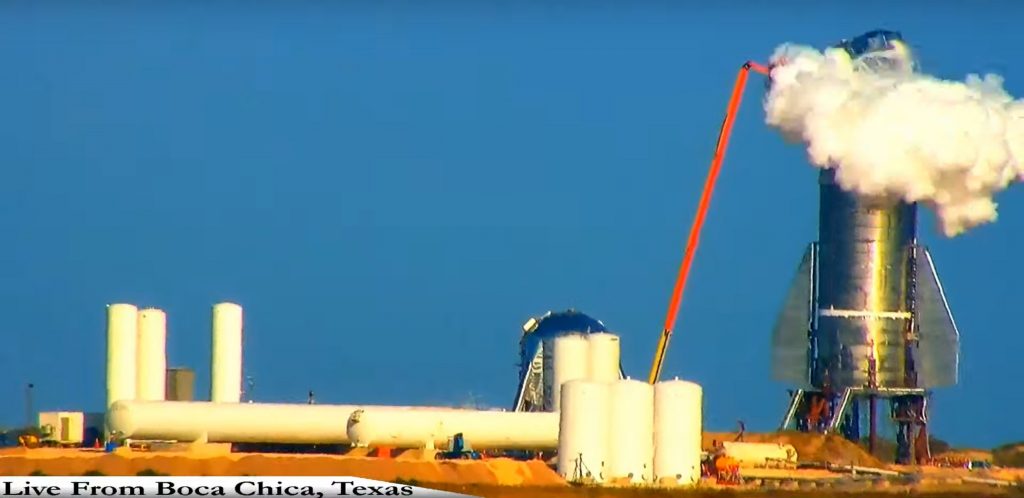
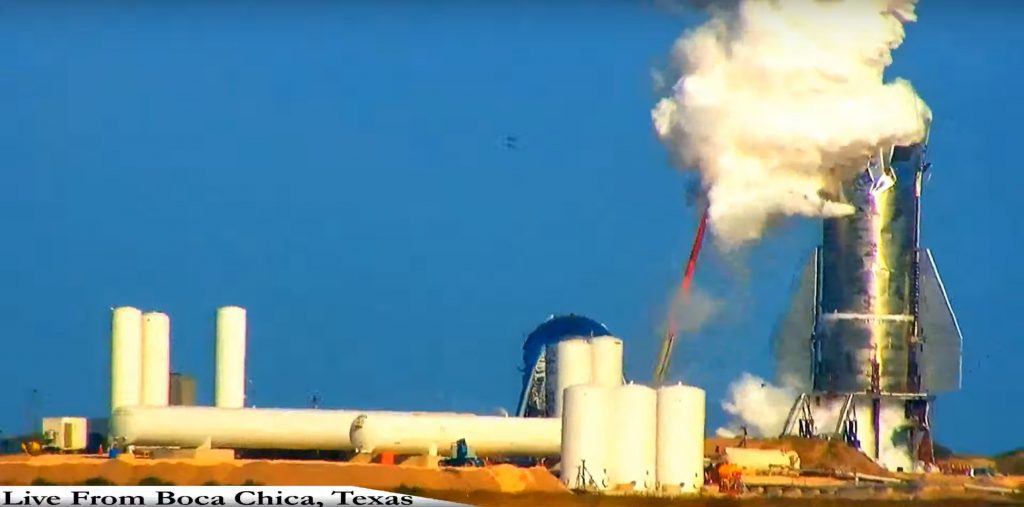
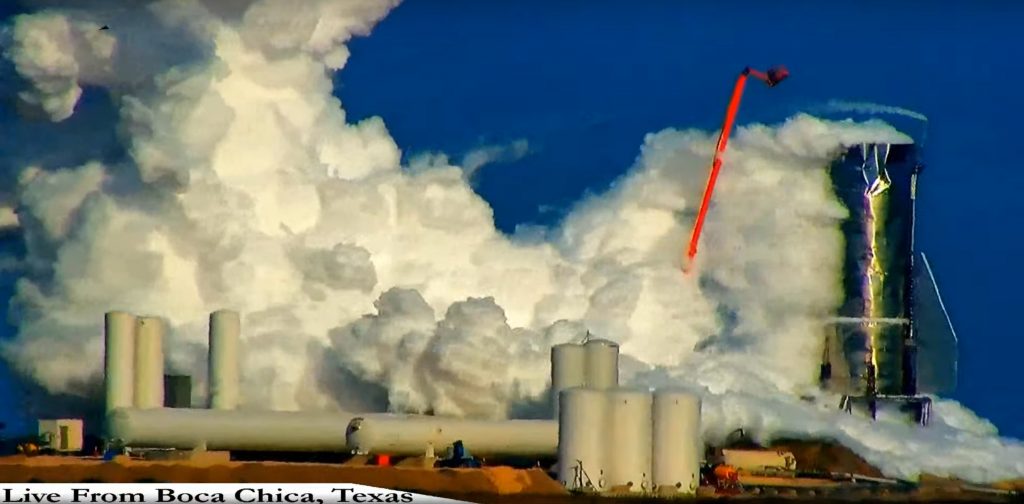


By all appearances, Starship Mk1 appeared to perform extremely well as an integrated system up to the point that its upper tank dome failed. The first frame from LabPadre’s stream with anything visibly amiss explicitly implicates the weld connecting the LOX dome to the cylindrical body of Starship’s LOX tank, point to a bad weld joint as the likeliest source of the failure. Although that hardware failure is unfortunate, Mk1’s loss will hopefully guide improvements in Starship’s design and manufacturing procedures.
Moving forward
Minutes after the anomaly was broadcast on several unofficial livestreams of SpaceX’s Boca Chica facilities, SpaceX CEO Elon Musk acknowledged Starship Mk1’s failure in a tweet, telegraphing a general lack of worry. Of note, Musk indicated that Mk1 was valuable mainly as a manufacturing pathfinder, entirely believable but also partially contradicting his September 2019 presentation, in which he pretty clearly stated that Mk1 would soon be launched to ~20 km to demonstrate Starship’s exotic new skydiver landing strategy.
Musk says that instead of repairing Starship Mk1, SpaceX’s Boca Chica team will move directly to Starship Mk3, a significantly more advanced design that has benefitted from the numerous lessons learned from building and flying Starhopper and fabricating Starship Mk1. The first Starship Mk3 ring appears to have already been prepared, but SpaceX’s South Texas focus has clearly been almost entirely on preparing Starship Mk1 for wet dress rehearsal, static fire, and flight tests. After today’s failure, it sounds like Mk1 will most likely be retired early and replaced as soon as possible by Mk3.
Above all else, the most important takeaway from today’s Starship Mk1 anomaly is that the vehicle was a very early prototype and SpaceX likely wants to have vehicle failures occur on the ground or in-flight. As long as no humans are at risk, pushing Starship to failure (or suffering unplanned failures like today’s) can only serve to benefit and improve the vehicle’s design, especially when the failed hardware can be recovered intact (ish) and carefully analyzed.
A step further, SpaceX is simultaneously building a second (and third) Starship prototype at its companion Cocoa, Florida facilities, and Starship Mk2 is nearly finished. Coincidentally, technicians installed its last tank dome – the same dome that failed on Mk1 – just days ago, and any insight that the Boca Chica team can gather from Mk1’s troubles will almost certainly be applied to Mk2, whether that means reinforcing its existing domes or fully replacing the upper dome with an improved design.
Check out Teslarati’s Marketplace! We offer Tesla accessories, including for the Tesla Cybertruck and Tesla Model 3.

Elon Musk
Elon Musk’s X will start using a Tesla-like software update strategy
The initiative seems designed to accelerate updates to the social media platform, while maintaining maximum transparency.

Elon Musk’s social media platform X will adopt a Tesla-esque approach to software updates for its algorithm.
The initiative seems designed to accelerate updates to the social media platform, while maintaining maximum transparency.
X’s updates to its updates
As per Musk in a post on X, the social media company will be making a new algorithm to determine what organic and advertising posts are recommended to users. These updates would then be repeated every four weeks.
“We will make the new 𝕏 algorithm, including all code used to determine what organic and advertising posts are recommended to users, open source in 7 days. This will be repeated every 4 weeks, with comprehensive developer notes, to help you understand what changed,” Musk wrote in his post.
The initiative somewhat mirrors Tesla’s over-the-air update model, where vehicle software is regularly refined and pushed to users with detailed release notes. This should allow users to better understand the details of X’s every update and foster a healthy feedback loop for the social media platform.
xAI and X
X, formerly Twitter, has been acquired by Elon Musk’s artificial intelligence startup, xAI last year. Since then, xAI has seen a rapid rise in valuation. Following the company’s the company’s upsized $20 billion Series E funding round, estimates now suggest that xAI is worth tens about $230 to $235 billion. That’s several times larger than Tesla when Elon Musk received his controversial 2018 CEO Performance Award.
As per xAI, the Series E funding round attracted a diverse group of investors, including Valor Equity Partners, Stepstone Group, Fidelity Management & Research Company, Qatar Investment Authority, MGX, and Baron Capital Group, among others. Strategic partners NVIDIA and Cisco Investments also continued support for building the world’s largest GPU clusters.
News
Tesla FSD Supervised wins MotorTrend’s Best Driver Assistance Award
The decision marks a notable reversal for the publication from prior years, with judges citing major real-world improvements that pushed Tesla’s latest FSD software ahead of every competing ADAS system.

Tesla’s Full Self-Driving (Supervised) system has been named the best driver-assistance technology on the market, earning top honors at the 2026 MotorTrend Best Tech Awards.
The decision marks a notable reversal for the publication from prior years, with judges citing major real-world improvements that pushed Tesla’s latest FSD software ahead of every competing ADAS system. And it wasn’t even close.
MotorTrend reverses course
MotorTrend awarded Tesla FSD (Supervised) its 2026 Best Tech Driver Assistance title after extensive testing of the latest v14 software. The publication acknowledged that it had previously criticized earlier versions of FSD for erratic behavior and near-miss incidents, ultimately favoring rivals such as GM’s Super Cruise in earlier evaluations.
According to MotorTrend, the newest iteration of FSD resolved many of those shortcomings. Testers said v14 showed far smoother behavior in complex urban scenarios, including unprotected left turns, traffic circles, emergency vehicles, and dense city streets. While the system still requires constant driver supervision, judges concluded that no other advanced driver-assistance system currently matches its breadth of capability.
Unlike rival systems that rely on combinations of cameras, radar, lidar, and mapped highways, Tesla’s FSD operates using a camera-only approach and is capable of driving on city streets, rural roads, and freeways. MotorTrend stated that pure utility, the ability to handle nearly all road types, ultimately separated FSD from competitors like Ford BlueCruise, GM Super Cruise, and BMW’s Highway Assistant.
High cost and high capability
MotorTrend also addressed FSD’s pricing, which remains significantly higher than rival systems. Tesla currently charges $8,000 for a one-time purchase or $99 per month for a subscription, compared with far lower upfront and subscription costs from other automakers. The publication noted that the premium is justified given FSD’s unmatched scope and continuous software evolution.
Safety remained a central focus of the evaluation. While testers reported collision-free operation over thousands of miles, they noted ongoing concerns around FSD’s configurable driving modes, including options that allow aggressive driving and speeds beyond posted limits. MotorTrend emphasized that, like all Level 2 systems, FSD still depends on a fully attentive human driver at all times.
Despite those caveats, the publication concluded that Tesla’s rapid software progress fundamentally reshaped the competitive landscape. For drivers seeking the most capable hands-on driver-assistance system available today, MotorTrend concluded Tesla FSD (Supervised) now stands alone at the top.
News
Elon Musk’s Grokipedia surges to 5.6M articles, almost 79% of English Wikipedia
The explosive growth marks a major milestone for the AI-powered online encyclopedia, which was launched by Elon Musk’s xAI just months ago.

Elon Musk’s Grokipedia has grown to an impressive 5,615,201 articles as of today, closing in on 79% of the English Wikipedia’s current total of 7,119,376 articles.
The explosive growth marks a major milestone for the AI-powered online encyclopedia, which was launched by Elon Musk’s xAI just months ago. Needless to say, it would only be a matter of time before Grokipedia exceeds English Wikipedia in sheer volume.
Grokipedia’s rapid growth
xAI’s vision for Grokipedia emphasizes neutrality, while Grok’s reasoning capabilities allow for fast drafting and fact-checking. When Elon Musk announced the initiative in late September 2025, he noted that Grokipedia would be an improvement to Wikipedia because it would be designed to avoid bias.
At the time, Musk noted that Grokipedia “is a necessary step towards the xAI goal of understanding the Universe.”
Grokipedia was launched in late October, and while xAI was careful to list it only as Version 0.1 at the time, the online encyclopedia immediately earned praise. Wikipedia co-founder Larry Sanger highlighted the project’s innovative approach, noting how it leverages AI to fill knowledge gaps and enable rapid updates. Netizens also observed how Grokipedia tends to present articles in a more objective manner compared to Wikipedia, which is edited by humans.
Elon Musk’s ambitious plans
With 5,615,201 total articles, Grokipedia has now grown to almost 79% of English Wikipedia’s article base. This is incredibly quick, though Grokipedia remains text-only for now. xAI, for its part, has now updated the online encyclopedia’s iteration to v0.2.
Elon Musk has shared bold ideas for Grokipedia, including sending a record of the entire knowledge base to space as part of xAI’s mission to preserve and expand human understanding. At some point, Musk stated that Grokipedia will be renamed to Encyclopedia Galactica, and it will be sent to the cosmos.
“When Grokipedia is good enough (long way to go), we will change the name to Encyclopedia Galactica. It will be an open source distillation of all knowledge, including audio, images and video. Join xAI to help build the sci-fi version of the Library of Alexandria!” Musk wrote, adding in a later post that “Copies will be etched in stone and sent to the Moon, Mars and beyond. This time, it will not be lost.”








